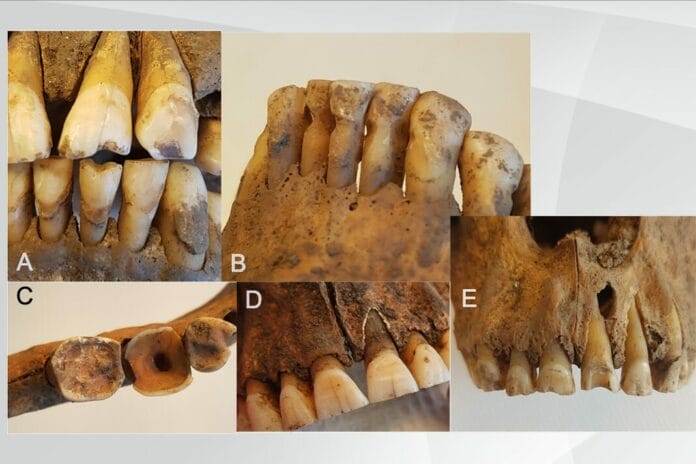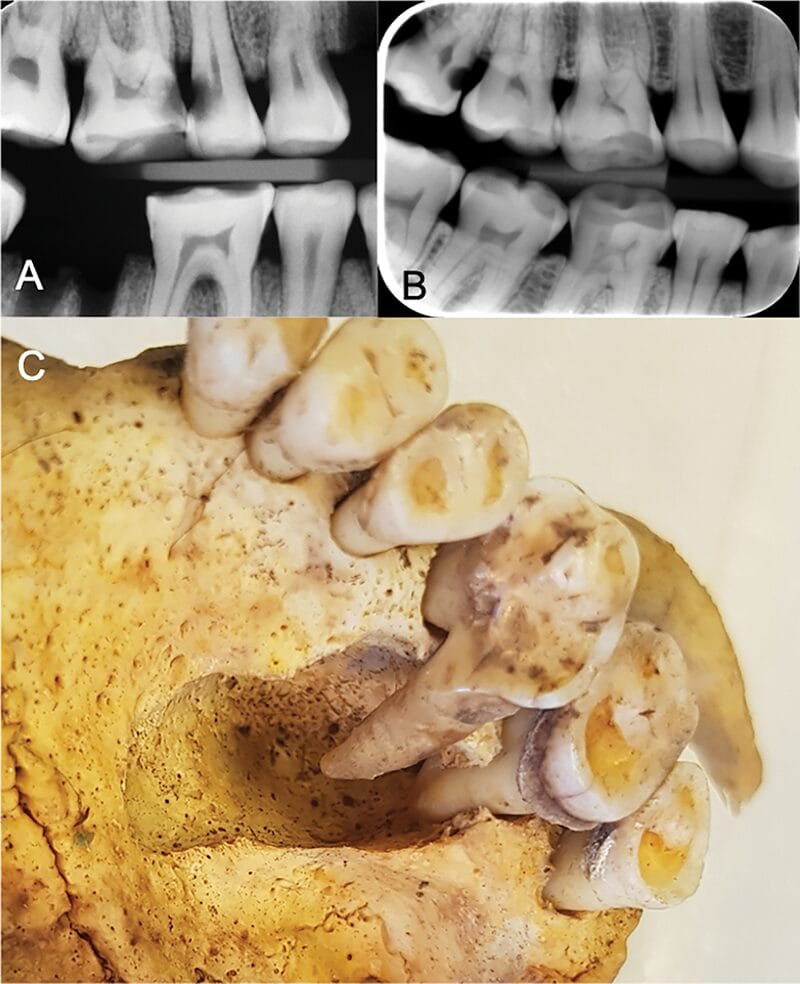
A) Signs of habitual wear of the central incisors, B) Signs of tooth picking in the mandibular incisors, C) Signs of modification with the opening of the pulpal chamber of a mandibular molar, D) Filed anterior teeth, and E) Modified central incisor with fistulated apical infection.
Image courtesy Bertilsson, C., et al.1 (CC BY 4.0 DEED)
Viking lore often conjures images of fierce warriors, longships, and far-reaching conquests, but a study conducted at the University of Gothenburg reveals another facet of Viking life that might surprise you: advanced dentistry. The findings from examining Viking Age teeth unearthed in Varnhem, Sweden, challenge the conventional perception of Viking dental care. This study sheds light on the prevalence of dental issues, from caries and tooth loss to periodontal disease, while also revealing remarkable instances of dental work that hint at a surprisingly sophisticated approach to oral health.1
The Study
The study delved into the teeth of 171 individuals from the Viking Age population of Varnhem, Västergötland, Sweden. Varnhem is known for its archaeological richness, featuring well-preserved skeletons and teeth in favorable soil conditions. Collaborating with an osteologist from Västergötland’s Museum, the University of Gothenburg’s Institute of Odontology research team transported the skulls and teeth to Gothenburg for clinical and radiographic examinations.1
Based on the presence of deciduous/mixed or permanent dentition, the study population was divided into two groups. The deciduous/mixed dentition group consisted of 38 individuals. The permanent dentition group consisted of 133 individuals, of whom 87 were male and 46 were female.1
The Results
The results uncovered a surprising reality. Among the Viking population in Varnhem, 49% had one or more carious lesions, and 13% of adult teeth had a carious lesion, often affecting the pulp. The caries prevalence rate was polarizing as some individuals displayed a remarkable number of carious lesions while others were caries-free or had only one or two carious lesions. This implies that some individuals had higher susceptibility to caries, as seen in today’s populations. Additionally, a high incidence of root caries was found, which could be linked to periodontal disease due to the marginal bone loss that was identified clinically and radiographically.1

In contrast to the adult population, the children with primary teeth and even those with mixed dentition remained caries-free.1
The occurrence of caries seen in this population could partially be attributed to the carbohydrate components of the diet, as barley, wheat, oats, rye, and peas were used to make porridge, soup, and bread. Additionally, the coarseness of the food most likely contributed to the attrition found in the teeth of those at Varnhem.1
Tooth loss was a common issue among adults. The study revealed that adults, on average, had lost 6% of their teeth (excluding wisdom teeth) over their lifetimes, with the risk of tooth loss increasing with age.1
Another important finding was the indication of infection in four percent of the teeth studied. The researchers found, “In the palate of one individual, a 30- to 35-year-old woman, bone resorption due to an extensive infection was seen in proximity to the palatal roots of teeth 26 and 27 [ISO tooth numbering system]. This infection would have been hazardous during the time period with no available treatments. It may very well be possible that the infection spreading through the soft tissues could have caused death, due to either obstruction of the airway, or sepsis.”1
Anatomical variations were found, such as enamel pearls in the molars of four individuals. One individual exhibited peg-shaped laterals, and two others had a non-erupted maxillary canine. Also, five individuals displayed aplasia: Four were missing tooth number 12 or 22, and another was missing both 45 and 35 (ISO tooth numbering system). Researchers rarely found crowding of teeth and malocclusion.1
The study also uncovered interesting examples of Viking efforts to maintain their dental health. “There were several signs that the Vikings had modified their teeth, including evidence of using toothpicks, filing front teeth, and even dental treatment of teeth with infections,” explains Carolina Bertilsson, a dentist and Associate Researcher, who was the study’s first-named and corresponding author.2 Notably, the areas of teeth with abrasion marks from using toothpicks showed no carious lesions. The filed anterior teeth found among the Viking remains hint at the possibility of these modifications serving as identity markers.1
One particularly fascinating find was molars with filed holes extending from the tooth’s crown into the pulp. This adaptation likely alleviated severe toothaches caused by infections, suggesting sophistication in dental procedures. Remarkably, this procedure bears a resemblance to modern dental treatments.1
Carolina Bertilsson summarizes, “This study provides new insights into Viking oral health and indicates that teeth were important in Varnhem’s Viking culture. It also suggests that dentistry in the Viking Age was probably more sophisticated than previously thought.”2
Conclusion
The study from Varnhem is a testament to the multifaceted nature of the Viking Age. While dental issues such as caries and tooth loss were prevalent, dental modifications and procedures among the Vikings suggest a more sophisticated approach to dental treatment than previously imagined.
The researchers concluded, “These are interesting and important findings that indicate that the Vikings in this population performed more complex interventions regarding dental diseases than the mere extraction of hurting teeth. There are several archaeological examples of prehistoric dentistry such as dental fillings from the Neolithic Period in Slovenia that had been performed using beeswax, as well as drilling of teeth in Neolithic Pakistan. However, this is the first time that signs of treatment of dental pathological conditions have been found in Swedish Viking remains.”1
Before you leave, check out the Today’s RDH self-study CE courses. All courses are peer-reviewed and non-sponsored to focus solely on pure education. Click here now.
Listen to the Today’s RDH Dental Hygiene Podcast Below:
References
- Bertilsson, C., Vretemark, M., Lund, H., Lingström, P. Caries Prevalence and Other Dental Pathological Conditions in Vikings from Varnhem, Sweden. PloS One. 2023; 18(12): e0295282. https://doi.org/10.1371/journal.pone.0295282
- University of Gothenburg. (2023, December 14). Viking Dentistry Was Surprisingly Advanced. ScienceDaily. www.sciencedaily.com/releases/2023/12/231214132600.htm










